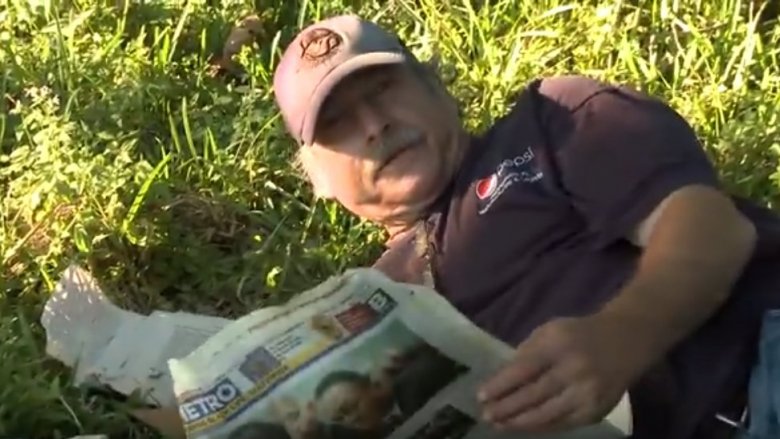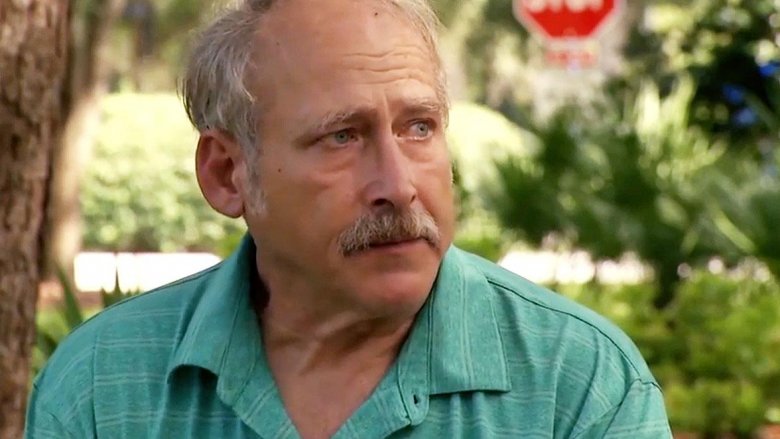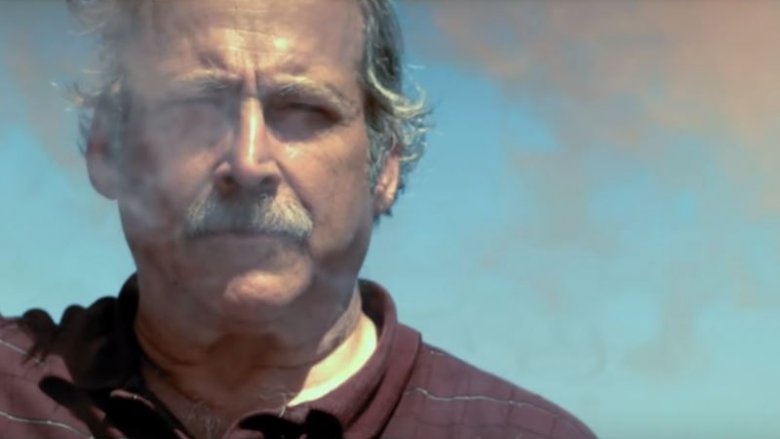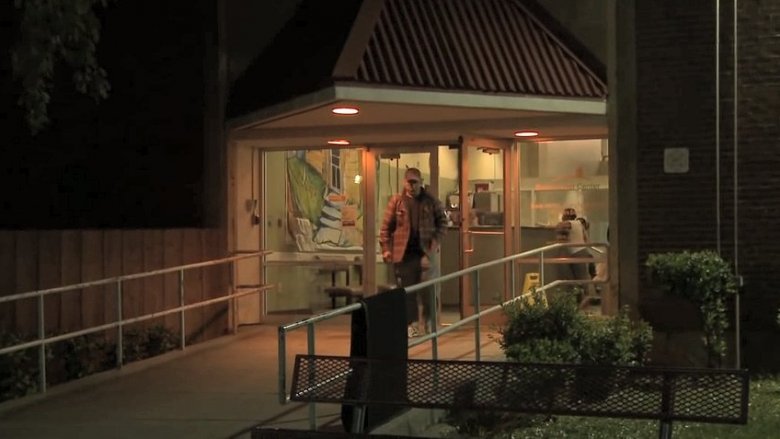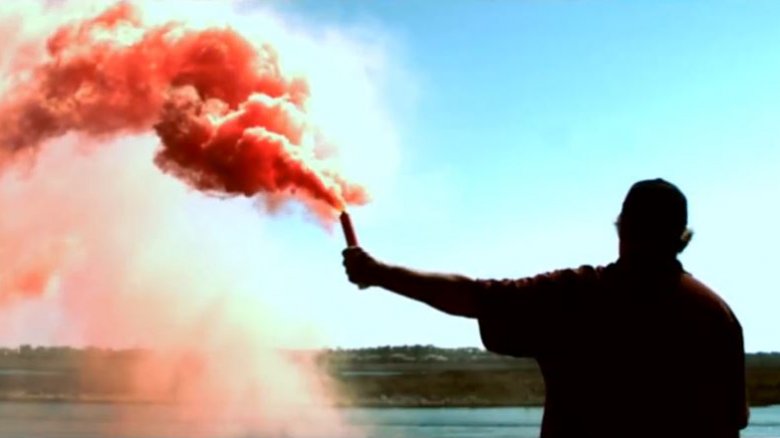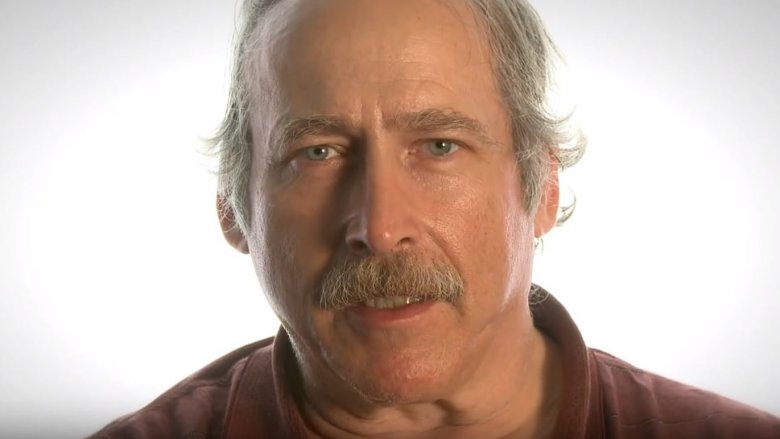The Crazy True Story Of The Guy Who Lost His Memory
The way amnesia is shown in movies has become such a cliché that it's easy to forget it's a real ailment. Of course, the way that Hollywood portrays it is pretty out there: how many times can we watch a protagonist get bopped in the head and lose their memory, only to get bopped again, and have it all come rushing back? In reality, amnesia is a lot scarier than that, and many real people have experienced the disturbing condition of not knowing who they are, where they came from, or what happened to them.
The story of "Benjaman Kyle," a pseudonym for an unnamed man who woke up in 2004 with no idea of who he was, is not for the faint of heart. However, Kyle's strange life is one of the most unique tales of recent times, and it all began on one hot afternoon in Georgia.
In 2004, a naked man was found by a dumpster
The saga of the man who called himself "Benjaman Kyle" began in 2004, according to The Guardian, on a hot day day in Richmond Hill, Georgia. The local Burger King was opening for business, and an employee was carrying trash out to the dumpster. To her shock, she stumbled upon a naked, middle-aged Caucasian man lying on the ground, covered in blood, sweat, sunburns, and fire-ant bites. According to the woman, he looked like "somebody tried to kill him."
Despite his terrible condition, the man wasn't dead. According to the Orlando Sentinel, no identification could be found, so he was assumed to be homeless. Paramedics came to the rescue and carted the unknown man to the hospital for treatment. Because he'd been found by a Burger King, medical workers took to calling him the "B.K. John Doe."
When the man finally woke up, he was right in the middle of a nightmarish scenario. For one, cataract problems in his eyes left him mostly blind. On top of that, medical workers kept asking for his name, but he couldn't answer. The man had no memory of who he was. No memory of how he had gotten there. No memory of his life up before the day he woke up in the hospital. Needing to answer to something, he named himself "Benjaman Kyle," based on the B.K. initials. Also, this odd spelling of "Benjaman" seemed familiar to him, but he wasn't sure why.
The mystery deepens
According to John Wikstrom's documentary Finding Benjaman, Kyle's lack of memories about his life and identity led to him being diagnosed with retrograde amnesia, a type of memory loss that Wikstrom calls the "Hollywood amnesia." That's because retrograde amnesia is the type of memory loss that the movie industry has made popular.
According to Cristen Conger of How Stuff Works, retrograde amnesia is generally caused by damage to parts of the brain other than the hippocampus. When a person suffers from retrograde amnesia, what becomes lost is that person's "episodic" memory, meaning memories of loved ones, personal experiences, their name, and so on, with more recent memories being the most susceptible to loss. What doesn't get lost in retrograde amnesia is their "procedural" memory. While the person suffering from this condition might not know their name, they'll still remember how to ride a bike, play piano, or cook a steak, as well as retaining their old personality and opinions. According to Simply Psychology, this is different from other forms of memory loss, such as anterograde amnesia — the condition portrayed in the movie Memento — which is where a person knows who they are, but is unable to form new memories.
In Benjaman Kyle's case, his condition made him a blank slate. When he was left for dead at that dumpster, he may have sustained a brain injury. Regardless, he became a man with no memories and no traces of an identity, starting from scratch.
A nurse helped him out
Benjaman Kyle's total lack of identity rendered him completely helpless, a condition that wasn't helped by his cataract problems. According to NPR, he spent the next nine months of his life being shuffled between medical institutions, with no identity, no home, and no way to reach out to anyone. His cataract issues, possibly a result of sun exposure when he'd been lying by the dumpster, had become so bad that he reportedly couldn't see more than a few feet ahead of him. Luckily, this vision problem was fixed when enough generous charity donations were raised to pay for his cataract surgery.
However, his identity was still missing, leaving him homeless. He eventually gained the empathy of a nurse named Katherine Slater, and the two became friends. In discussions with Kyle, Slater came to realize that because the man couldn't remember his social security number, he couldn't get a new photo ID or a new social security card, and definitely not a job or apartment. His ability to get by was completely dependent on whether anyone was willing to help him.
Slater assisted Kyle by pushing him to get the word out there. She convinced him that he could find help if he wrote letters to local politicians and media outlets. Kyle did so, opening the doors for the search of a lifetime.
The hunt begins
According to writer Matt Wolfe of the New Republic, the nurse figured that once politicians and the media got involved, Kyle's identity would be found in a flash. She said she estimated about "six months to figure out his real name, tops." After all, in the era of the internet, cell phones, and social media, no person on Earth could disappear for very long, right?
Wrong. Benjaman Kyle's true identity couldn't be found. The police tried to track his history. Journalists pounced on the case, trying to piece together the scattered details Kyle did recall. According to NPR, the senator Kyle contacted went right to the FBI, who ran Kyle's fingerprints, with FBI special agent Bill Kirkconnell figuring that Kyle probably would have either a criminal background or a past record of military service. The FBI couldn't find anything, and neither could anyone else. It was as if Kyle had never had a past before that day he woke up by the dumpster, as if he had just dropped from the sky, out of thin air.
Nonetheless, Benjaman Kyle didn't give up the search for his identity. He took his search to the next level and managed to get on TV.
He went on Dr. Phil
Perhaps the height of Benjaman's Kyle's media coverage was when he snagged a spot on Dr. Phil in October 2008, according to The Guardian. In addition to being a household name, Phil McGraw's broadcast regularly pulls in about seven million viewers on new episodes, and reruns air constantly across the world, so Kyle's appearance on the series gave his case an unprecedented level of attention, with millions of eyes seeing his face for the first time. To better ensure Kyle's odds of being discovered, the Dr. Phil team even created age regression images of Kyle in case any loved ones or family members might not have seen him for a decade or two.
Some positive results came from the Dr. Phil appearance, for sure: Kyle recited a couple vague memories he had, and his descriptions of the Denver transportation system were dated to the 1980s, while his equally vague memory of buying sandwiches for 25 cents at the Indianapolis State Fair was dated to the 1950s. But shockingly enough, that was it. Despite the millions of people who watch Dr. Phil everyday, none of them recognized the mysterious man with no name. His story continued, unsolved. At this point, according to the Finding Benjaman documentary, the media "gave up." As Kyle put it, everyone wanted footage of the day he might finally reunite with his long-lost family, but no one wanted to help him with the now-painstaking search. He was on his own again.
He was turned away from homeless shelters
The missing man was left adrift in an ocean of bureaucratic messiness. Due to the convoluted nature of U.S. laws, which weren't really written to account for unique cases like his, Kyle had spent years floating around with no social security number, no ID, no birth certificate, and no ability to get a job or an apartment. He couldn't even get a library card.
But it got even worse. Kyle found that without any form of ID, he was completely unable to get lodging in a homeless shelter. He could explain his terrible situation as much as he wanted, but while the workers at the homeless shelters were sympathetic, there was nothing they could legally do for him without some form of identification. No meals, no bed, no shelter.
Because of this, Benjaman Kyle ended up sleeping outside every night, truly homeless, tucking in on the field behind the police department with a newspaper stuffed behind his head as a makeshift pillow. Kyle's situation reached such a low point that he would later say, "Sometimes I just wish I hadn't woke up."
The documentary turned everything around
The documentary Finding Benjaman was the creation of John Wikstrom, a 21-year-old student at Florida State University, according to the New Republic. The short film showed an honest depiction of the real hardships Kyle faced in his struggle to make a day-to-day life for himself, with a special emphasis on his inability to find a place to sleep. As Wikstrom put it, what he tried to show in the film was that Kyle was "not this TV character who's scouring the globe. ... He's not worried about that. He's worried about eating." The film screened at the Tribeca Film Festival and at Cannes. Wikstrom also set Kyle up with a Facebook page, a website, and a petition for the government to issue him a new social security number.
The new attention Wikstrom brought to Kyle's case proved to be a lifesaver. Things finally turned around. The state of Florida issued Kyle a special "legacy ID" using his new name, and local restaurant owner Josh Schrutt hired him on as a dishwasher.
While Kyle's identity was still a mystery, he at least had a job, a bed, and a pillow to rest his head on. Working in the kitchen, he soon realized that he had extensive knowledge of kitchen equipment, to such a degree that he'd almost certainly worked a prior kitchen job, somewhere in the past. But where?
In 2015, his identity was found
By 2015, Kyle had spent over a decade under a new name with a new life, and no one from his past had ever reached out. The future didn't look bright. After 11 years of being Benjaman Kyle, the amnesiac man had given up hope that his true identity would ever be discovered. Then in 2015, a genealogist named CeCe Moore — who had spent two years looking into Kyle's case — finally cracked the mystery.
The secret link proved to be a yearbook photo in the 1967 Nautilus, put out by a high school in Lafayette, Indiana. In late 2015, as reported by Journal & Courier, Benjaman Kyle's true name was discovered: he was actually William "Bill" Powell.
Bill Powell even had a brother back home in Lafayette: an injured Vietnam veteran named Furman Powell, who hadn't heard or seen from his little brother in decades. Still bowled over with shock and disbelief, the man who had been Benjaman Kyle traveled up to Indiana to reunite with the sibling he never knew he had. Finally, after all those years of wandering and wondering, Bill Powell could fill in some missing pieces.
Who is William 'Bill' Powell?
It took some time for the details of Bill Powell's true life to be released to the public — understandably so, given that after all those years of searching, Powell had earned some privacy — but finally, the Powell brothers revealed the truth to Matt Wolfe of the New Republic.
Bill Powell came from tragic beginnings. Their father, Furman Sr., was a World War II veteran and an abusive alcoholic who may have had PTSD, according to the younger Furman. Their mother, Marjorie, a former Navy photographer, became an addictive hoarder, filling the house with mountains of objects. Bill was Marjorie's favorite child, and Dad physically abused Bill in a manner that was "regular and brutal." Evidently, the situation got bad enough that Bill moved out when he turned 16. Up until his mid-twenties, Bill worked a number of scattered jobs. One day, he suddenly fled from his past and took refuge in Boulder, Colorado.
It was in Boulder that Bill started working in the kitchen, but the painful experiences he'd run away from continued to haunt him, leading to heavy drinking and smoking. Weirdly, after 1983, the paper trail stops. All records of William Powell disappear. Bill's disappearance led the Powell family to assume he was dead, which was especially painful for his mother. Either way, those years from 1983 until that fateful day in 2004 are still a mystery, and may forever remain a blank spot in Bill's life.
Where is Bill Powell today?
The biggest inaccuracy about the Hollywood version of amnesia is that in the movies, when an amnesiac characters gets bopped on the head a second time, their memories come flooding back to them. They smile, laugh, recognize all their old friends and family. In real life, it isn't that neat and tidy. In cases like this, the lost memories usually never come back.
By late 2015, Bill Powell moved back home to Indiana, in order to help take care of his aging brother Furman, and reunited with all his previously unknown family members. They all told him stories about his life, but as he explained to the New Republic, he still couldn't recognize any of them. Nonetheless, having finally recovered his identity, Bill was able to secure a two-bedroom house in Lafayette. Today, Bill Powell says he loves his independence, no longer having to depend on the kindness of others to get through the day. He does worry that being back in the town he ran away from in his twenties may bring back painful repressed memories, but he's willing to face them.
Thanks to a cousin, the former Benjaman Kyle also has a copy of his family tree. According to writer Matt Wolfe, Bill enjoys tracing his lineage. "It's the idea of looking at all these names, knowing that I'm descended from all these people," he said. "I have a history now."

